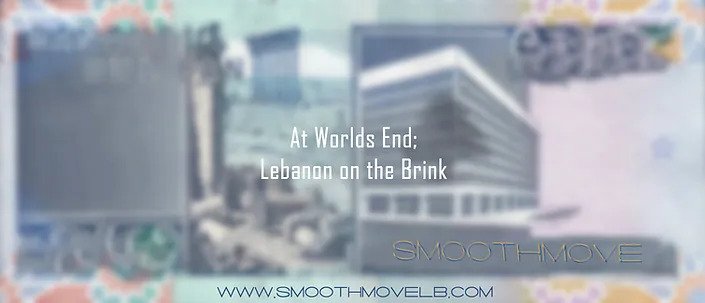
- 30 Nov-2022
At Worlds End; Lebanon on the Brink
With bigger concerns on its agenda, Central Bank taps out of the fight for the real estate sectors life, leaving the country in frenzy.
The past months have seen some very interesting rhetoric being spread around Lebanon. Whether it is a Whatsapp message, a newspaper article, or an evening news report, a narrative of an economic and financial crash has been gaining momentum around the country. It has become such a widely discussed topic that EXECUTIVE magazine dedicated its October print issue in entirety to the state and future of the real estate sector. We are at a point where it is almost consensual that the country is headed towards a collapse. While everything has been done to postpone this moment, the moment has nevertheless arrived. For years, the Central Bank and its Governor Riad Salemeh have been pulling rabbits out of hats, attempting to keep the real estate sector from sinking. All while maintaining the state of the Lebanese Lira in one hand, and financing government spending in the other. A feat resembling a circus act of a man juggling a bowling ball, a Molotov cocktail, and a baseball bat, all while riding a unicycle with a gun aimed at his head. Financial engineering hysteria aside, the time is ticking on Lebanon’s economy, as funds for subsidized programs are long gone, and all parties involved have little cards left to play. It is time for some real life, serious governance and policy making in Lebanon. Something that, frankly, this writer has a hard time believing the current political class is capable of doing.
ISKAN LOAN PROGRAMS
A key to understanding the state of the real estate sector today is by understanding the ISKAN Loan program. A few years back the Lebanese Central Bank, in an attempt to shore up the real estate sector, introduced a program where it offered housing loans that differed from your typical housings loans. Unlike typical housing loans, ISKAN loans had a longer period of repayment (sometimes up to 30 years), as opposed to 10-15 years granted by normal loans. The interests on ISKAN loans were SIGNIFIANTLY lower than normal loans, around 3% for ISKAN, compared to typically 7%. Essentially, ISKAN loans were subsidized, meaning all loans were backed up by the Central Bank. Whenever you see the word SUBSIDIZED think cheap money. This made ISKAN loans INCREDIBLY attractive to newly-weds and young married couples. So attractive that an injection of $500 million into the program in February 2018 saw the funds depleted within a month (Daily Star 2018).
Just recently the Central Bank stopped the ISKAN loan program altogether, but not before pledging to inject a final and mere $66 million into the program, made to be available early 2019. Speculations as to why the Central Bank stopped the program vary from lack of funding, to desire to maintain the Liras value and not drive up inflation, and most infamously the widespread use of corruption with the program. Since money offered by ISKAN was so cheap, users turned abusers would take out a loan for 3% and park it in a Bank account, that offered up to 9% interest on Lira deposits. Also, there is the scandalous, yet vague, Najib Mikati story, where the Billionaire, former prime minister used the ISKAN loan program to take out a $1 million loan with only 1% interest. With all that being said, the ISKAN program was never considered a permanent solution for the real estate sector. It was simply the Central Banks attempt to keep the sector afloat while the Government got its shit together and came up with a more permanent long-term solution. Needless to say, the Government, or lack thereof, never did get its shit together; now the program has come to a screeching halt, triggering the talks of a crisis. With no more cheap money available, demand for real estate, across the board, in Lebanon has vanished. Leaving developers, the government, and the banks in a very awkward situation.
How exposed are the Banks?
The banks efforts to stimulate the sector did not stop at ISKAN loans. Homebuyers weren’t the only ones looking for funds. With demands and purchasing power low, the only means builders had to fund their projects were if they used their own money. Of course, knowing the ever so business-savvy Lebanese versions of Stephen M. Ross (Google him) that was out of the question. So developers head to the banks. This is where things become very interesting. The Banks know there is little to no demand for real estate, yet opened up their doors for developers to receive financing for their projects to be constructed. Why would they do that? Why invest in something and help build it when you know there is essentially no end-user for it? Bruno Marot (PhD) a man who specializes in Housing finance and policy, explains, “the fast paced deployment of mortgage-based homeownership has also sought to sustain consumption based growth and to shield the local banking industry from a range of financial risk” (Marot 2018). Essentially banks saw an opportunity in the real estate industry that would ultimately protect them from a different type of catastrophe. By increasing the amount of private debt on their books by loaning to developers; using their expensive property assets as high quality collateral, they were able to contain the countries sovereign risk, which is the ability as a country to repay its debt. In Laymens terms, Banks pumped money into the real estate sector, which allowed the economy to keep going to some extent thus preventing all types of other financial risks.
This brings us to the question, just how exposed are the Banks? According to a study by the WorldBank and the IMF the banking system is SIGNIFICANTLY exposed to the real estate sector, “with more than 90 percent of all loans to the private sector exposed either directly (through housing loans to end users, loans to developers, contractors, and to other real estate professionals) or indirectly” (World Bank 2016). This has made the financial industry and real estate sector vulnerable to each other. Any sharp increase in the delinquency rate of property loans will send property prices down. Also any plunge in property asset values will send ripple effects into the credit systems stability. So to answer the question: how exposed are the banks? Pretty fucking exposed. With the Banks loan books being neck deep in real estate related debt, any crash in one sector will see it drag the other sector down with it.
A lot of Questions, Very Little Answers
The Central Bank has ultimately ended all assistance to the real estate sector in an attempt to prioritize the financial industry. Local banks are majorly exposed to private real estate debt and have begun selling off their international bond portfolio. As for the so-called Government, I wouldn’t bet my money on them coming up with a clear strategy for the real estate sector, or any sort of strategy for any sector for that matter. Ultimately we are left with more questions then answers.
Are we in a crisis?
Who is it a crisis for? The Banks? The Consumer?
Is there a price correction occurring?
I have stated in my previous posts that the market is witnessing a correction in prices. While this is something developers don’t want to hear, it is true, and could be beneficial in the long run. Property prices in 2010 were simply not sustainable, especially considering the annual income in Lebanon as well as the very low annual GDP growth. I would say developers of the luxurious high-end towers situated in Downtown have it the worst. Our current relations with the Gulf are the lowest they’ve been in years. I don’t see us somehow kissing and making up with our Middle Eastern counterparts overnight. Also Barring any extreme drop in asking price, it’s almost impossible to see any match between existing supply of luxury residential towers with todays market participants. The developers that have wisened up to the market constructed small apartments and emphasized quality and appropriate pricing. They have strategically placed themselves to reap the most benefits in the event of a market upturn.
The Road Ahead
Nonetheless, clear government housing policy is CRUCIAL for any sort of revival to the real estate market. It is absolutely CRAZY that in a country that allocates so many ministries, we do not have a clear governing entity for our biggest economic sector. With that being said, the Government should adopt a paradigm of real estate regulations and reforms, starting with planning regulations, stricter buildings designs, affordable housing, controlling building permits, as well as a grocery list of other important reforms.
Are we in a crisis? As of today it is in my opinion we are not. But after years of attempting to avoid it rather than prevent it we are closer then ever. Rest assured it will be a crisis that hits everyone. It may be that by the time you are reading this, a government will have been finally formed but probably not. Even if one is formed, that will simply not be enough to revive the economy time around. We have to keep adopt a self sufficient and sustainable solution years to come. We HAVE to look at the big picture. The real estate sector can be like a paddleboat where we continue to exert tiresome efforts to keep the boat moving. Or it can be a sailing ship, relying on market winds to allow it to sail, with a clear policy in place to steer it from any dangers at sea. For the sake of the economy, the financial industry, the country, this generation and the generation next, it will have to be the latter. As soon as the last breath of air in the form $66 million ISKAN funding by the central bank dries up, we will be looking at a morbid real estate body, and an epidemic of financial risks spreading across the country.
References:
- FINANCIAL SECTOR ASSESSMENT LEBANON . 2016, p. 13, FINANCIAL SECTOR ASSESSMENT LEBANON .
- “Housing Loan Funds Depleted by Demand: BDL Head.” The Daily Star Newspaper - Lebanon, www.dailystar.com.lb/News/Lebanon-News/2018/Mar-05/440309-aoun-to-salameh-provide-agreed-upon-housing-loans.ashx
- Marot, Bruno. “Pegged Urbanization and the (in)Stability of Lebanese Capitalism.” Executive Magazine, 4 Oct. 2018, p. 38.

